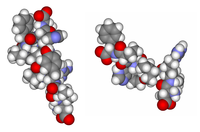
Photo from wikipedia
Red deer (Cervus elaphus) blood is widely used as a health product. Mixed culture fermentation improves the flavor and bioavailability of deer blood (DB), and both DB and its enzymatic… Click to show full abstract
Red deer (Cervus elaphus) blood is widely used as a health product. Mixed culture fermentation improves the flavor and bioavailability of deer blood (DB), and both DB and its enzymatic hydrolysates exhibit anti-fatigue activities in vivo. To elucidate the bioactive ingredients, enzymatic hydrolysates were fractioned into different peptide groups using reversed phase resin chromatography, and then evaluated using an exhaustive swimming mice model to assess swimming time and biochemical parameters. The structures of the bioactive peptides were elucidated by high performance liquid chromatography with tandem mass detection. Thirty-one compounds were identified as glutamine or branched-chain amino acids containing short peptides, of which Val-Ala-Asn, Val-Val-Ser-Ala, Leu(Ile)-Leu(Ile)-Val-Thr, Pro-His-Pro-Thr-Thr, Glu-Val-Ala-Phe and Val-Leu(Ile)-Asp-Ala-Phe are new peptides. The fractions containing glutamine or valine short peptides, Ala-Gln, Val-Gln, Val-Val-Ser-Ala, Val-Leu(Ile)-Ser improved exercise endurance by increasing hepatic glycogen (HG) storage. The peptides group containing Leu(Ile)-Leu(Ile), Asp-Gln, Phe- Leu(Ile), Val-Val-Tyr-Pro contributed to decreased muscle lactic acid (MLA)accumulation and to an increase in HG. The anti-fatigue activities of DB hydrolysates were attributed to the synergistic effects of different types of peptides.
Journal Title: Molecules
Year Published: 2021
Link to full text (if available)
Share on Social Media: Sign Up to like & get
recommendations!